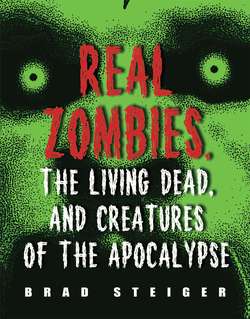Читать книгу Real Zombies, the Living Dead, and Creatures of the Apocalypse - Brad Steiger - Страница 42
На сайте Литреса книга снята с продажи.
OUT OF AFRICA
ОглавлениеIn September 2001, someone made a ghastly discovery in the River Thames, London, England. Floating in the water was the mutilated torso of a small black boy. His head, arms, and legs had been viciously hacked off.
Investigators of the grisly crime had nothing to work with in their attempt to reveal the young victim’s identity. An autopsy yielded little additional information except for an estimate of his age to be around four to seven years.
The detectives were shocked by the crime and maddened that they had no face, fingerprints, or dental records to assist them in their investigation.
Enough of the boy’s neck remained to permit a forensic expert to conclude that his throat had been cut and that the body had been deliberately drained of blood.
Scotland Yard called in additional forensic experts from various universities to assist them by using the latest scientific methods to examine the boy’s bones, stomach, and intestines for any clues at all.
Ken Pye, a forensic geologist at the University of London, found traces in the victim’s bones of strontium, copper, and lead that were two and a half times greater than would be normally expected of a child living in Britain. Pye’s meticulous research revealed that the boy had recently arrived from West Africa.
The forensic team, working on the contents of the boy’s stomach and intestines, discovered unidentifiable plant material, not at all native to England. In addition, the team attempted to analyze a strange mixture of sandlike material, clay pellets, and flecks of gold. Plant anatomists identified the strange plant material as coming from the calabar bean, a highly toxic vine that could be found in West Africa.
Writer James Owen said that Wade Davis, an anthropologist with the National Geographic Society, immediately noted the use of the calabar bean as a plant that was often used in West Africa to create a variety of poisons, many of which result in total paralysis and a very painful death.
A U.K.-based expert on African religions and Voodoo, Richard Hoskins, commented that the calabar bean, in combination with other ingredients in the boy’s stomach and intestines, indicated the West African country of Nigeria. Witch doctors commonly used such potions for black magic.
After an exchange of data, the investigators and the forensic experts agreed that the boy had been smuggled into the country for the sole purpose of serving as a human sacrifice.
While Hoskins said that human sacrifices are not common occurrences in contemporary celebrations of Voodoo or Black Magic rites, they still do take place. Animal and fowl sacrifices are regularly practiced, but the ceremonial sacrificial killing of a human is considered a vital element in the most empowering of magical rituals. Special police teams in Southern Africa have estimated that there may be as many as 100 human sacrifices a year—and the most powerful magic of all is created when a child is placed on the altar.
In many parts of Africa, certain witch doctors practice a traditional form of medicine called muti. The more unscrupulous of these witch doctors use body parts of children to increase their powers.
According to James Owen, Ken Pye and his forensic team were finally able to trace the murdered black boy’s bones to locate his birthplace at a region near Benin City in southwestern Nigeria. According to many authorities, vodun began 350 years ago in Benin. In 1996, vodun, or Voodoo, won state recognition. January 10 was inaugurated as National Voodoo Day, and the religion that is practiced by 65 percent of the 5.4 million Beninese took its place alongside Christianity and Islam.
Voodoo (vodou, vodoun, vudu, or vudun in Benin, Togo, southeastern Ghana, Burkina Faso, and Senegal; also vodou in Haiti) is a name attributed to a traditionally unwritten West African spiritual system of faith and ritual practices. Like most faith systems, the core functions of Voodoo are to explain the forces of the universe, influence those forces, and influence human behavior. Voodoo’s oral tradition of faith stories carries genealogy, history, and fables to succeeding generations. Adherents honor deities and venerate ancient and recent ancestors. This faith system is widespread across groups in West Africa. Diaspora spread Voodoo to North and South America and the Caribbean.
A New Orleans Voodoo altar contains a wide variety of sacred objects to be employed in performing rituals of healing and other magical practices (art by Ricardo Pustanio).
On the inauguration of National Voodoo Day, Sossa Guedehoungue, the 86-year-old High Priest of Voodoo, held an audience at his hometown of Doutou, on the Togo border, and scoffed at those who considered Voodoo dangerous. Sossa made a sweeping gesture with an arm to indicate his 24 wives, more than 100 children, and 300 grandchildren and declared that if Voodoo were evil, none of them would be there.
Numerous practitioners of Voodoo insist that the practice developed a more sinister side only after the slave trade shipped millions of West Africans to Haiti, Cuba, and the Americas. The Old Gods followed their captive people to help them survive and to cast evil spells upon those who enslaved them. At the same time, the people who were carried far from their home villages cleverly began to use the names of Catholic saints to disguise the ancient ones in their pantheon of gods under the names of those whom their captors deemed holy.
